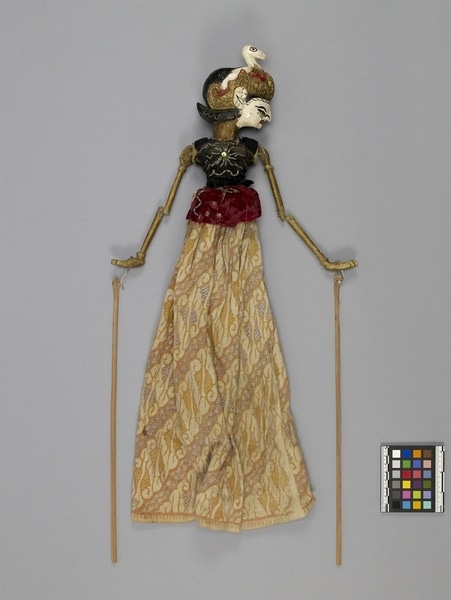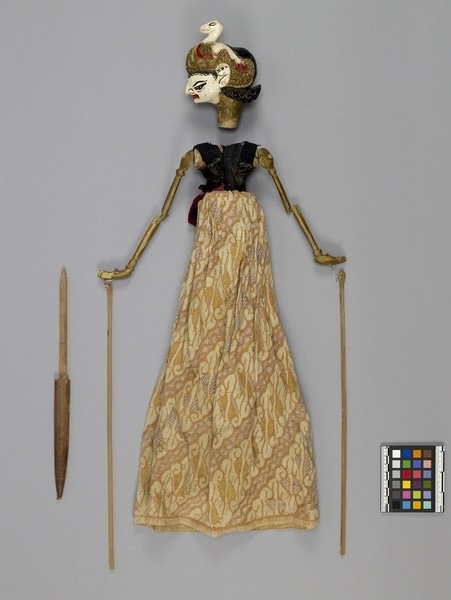Rod Puppet Item Number: Ib294 a-c from the MOA: University of British Columbia


Description
Three-dimensional male humanoid puppet: large head (part b) fits into body with vest and skirt (part a), and a control rod (part c) with a long shaft passes through the body and fits into the neck of the figure's head. The body has jointed arms, each with a long controlling rod attached. The figure has a gold painted torso and arms. Hands bent back at right angles, fingers slightly curved upwards. Face painted white, with narrow straight nose, slit-like eyes, with lowered lashes and narrow red mouth. Face cast in downwards gaze. Cap-like headdress and with elaborately carved gold jamang, topped by garuda (bird-shaped ornament); also with upper sumping and ngore. The figure is wearing a black velvet vest with a beaded star-shaped pattern on chest and a gold sequin at the centre. The beads are clear with a frosted finish, and green. Dark red velvet beaded apron with three star-shaped, clear sequins and metal beads in a T-shape at the centre. Light purple, orange, yellow and off-white batik skirt.
History Of Use
Javanese puppetry as an art form probably developed by the 11th century. The three-dimensional wooden wayang golek puppets of western Java, which are to be distinguished from the earlier and more sacred wayang kulit shadow plays puppets or other forms, appeared during the 16th century. Originally the plays depicted Javanese mythology, but after the Indian conquest of Java the Hindu epics, Ramayana and Mahabharata, were incorporated into the cycles, which comprise about 200 plays. An individual or group hires a dalang (puppet-master) to celebrate important occasions. The performances often last all night and are generally presented in three acts, with vocal and instrumental accompaniment. The individual plays vary widely in detail but usually involve conflict between good and evil. They serve a moral and religious purpose, and more recently, one of political commentary. Each puppet's character is represented by its appearance and placement onstage; protagonists with strong elements of good are placed to the right, antagonists of violent or evil nature to the left. Bayi can appear in plays based on either the Mahabharata or Ramayana cycles of legends. As one of the five Pandawa brothers who are constantly in conflict with the evil Kurawas, he portrays a noble hero. The noble warrior figure is central to the ritual struggle between good and evil; conflict tests the honour and individual qualities of the hero. Therefore, his virtuousness and skill in warfare are related.
Cultural Context
Theatrical performance.
Iconographic Meaning
White down-turned face, fine facial features, such as small mouth, nose and eyes, batik skirt, elaborate costume and headdress, and curved fingers are indicative of noble status as are the diadem and sumping, which are reserved for deities and royalty. Gold coloured body represents youth. Character of puppet identified as Bayi, third of the Pandawa brothers who appears in the Mahabharata cycle. Bayi is also found in the Ramayana epic, in which he appears as a diverse character, often (as suggested by the colour of his skin) as a baby.
Item History
- Made in Java, Indonesia
- Owned by Tradewind Antiques before March 15, 1983
- Received from Museum of Anthropology Shop Volunteers (Funding source) and Tradewind Antiques (Seller) on March 15, 1983
What
- Name
- Rod Puppet
- Identification Number
- Ib294 a-c
- Type of Item
- puppet
- Material
- wood, cotton fibre, paint, fibre, glass and metal
- Manufacturing Technique
- nailed, carved, painted, woven, batiked and machine manufactured
- Part A
- height 53.7 cm, width 10.5 cm, depth 6.0 cm
- Part B
- height 12.5 cm, width 6.7 cm, depth 9.0 cm
- Part C
- height 28.7 cm, width 2.0 cm, depth 1.0 cm
Who
- Culture
- Sundanese
- Previous Owner
- Tradewind Antiques
- Received from
- Museum of Anthropology Shop Volunteers (Funding source) and Tradewind Antiques (Seller)
Where
- Holding Institution
- MOA: University of British Columbia
- Made in
- Java, Indonesia
When
- Ownership Date
- before March 15, 1983
- Acquisition Date
- on March 15, 1983
Other
- Condition
- fair
- Accession Number
- 0886/0028 a-c